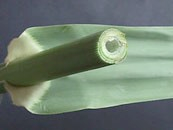The Stems.
In the cross section Arundo donax, the epidermis shows a regular pattern of normal epidermal cells which are small and thick walled interspersed with clear oval-shaped silica cells. Several layers of parenchyma cells are found immediately under the epidermis.
These cells contain the filler or backing. This tissue can be found in all parts of the plant. Herbaceous plants are mainly made up of this tissue. In this region the parenchyma cells are relatively small and thick walled in contrast to the large thin walled parenchyma cells found in the inner region of the stem. Substances are transported from the roots to the stems and leaves through the transport system. It is first transported from one cell to the next one through the water absorbed by the root hairs that contain the nutritive salts. However, it appears quickly in one of the small tubes, the veins. These veins are called vascular bundles when they are bundled together. Vascular bundles are scattered throughout the stem in a pattern very similar to that found in corn and other members of the grass family: Very small vascular bundles are found close to the surface of the stem. The size of the bundles increases toward the center. Each vascular bundle consists of a ring of fiber cells surrounding the xylem and phloem. The vascular bundles are what the bassoonplayer refers to as the "fiber" or "grain" of the reed. Stems in a more mature state of development have more parenchyma cells with very thick walls. Fiber cells also develop extremely thick walls with age. Reed is older, therefore it has a thicker bark (with literally rock-hard silica cells) and a thicker wall, thus more solid parenchyma and fibre cells. Therefore, it is considered to be more solid. The conditions during growth, such as composition of the soil, temperature and moisture levels influence the final quality of the plant. However, the farmer's knowledge as regards the best harvesting time and the treatment of the reed after the harvest also has a major impact on its final quality.



